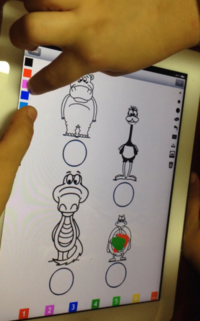Avaliação da usabilidade de ícones de aplicativos de dispositivos móveis utilizados como apoio educacional para crianças na idade pré-escolar
Ícones utilizados em aplicativos de jogos educativos infantis para dispositivos móveis apresentam problemas de usabilidade que induzem as crianças a erros e levam à desmotivação, como por exemplo o abandono da tarefa. Esta pesquisa, estruturada em seis capítulos, apresenta os resultados de um estudo dos ícones utilizados na interface de aplicativos de jogos educativos para crianças na idade pré-escolar, seu reconhecimento e consequente eficácia no auxílio da educação. O objetivo desta pesquisa é contribuir para o desenvolvimento de ícones que representem as atividades infantis em ambiente virtual. No primeiro capítulo são abordados os conceitos de ergonomia informacional e usabilidade, os critérios ergonômicos e conceitos semióticos para a compreensão da interação homem-computador e nos aspectos relacionados ao reconhecimento e significação dos ícones. No segundo capítulo, são elencados os pontos importantes para o entendimento da educação e sua relação com a tecnologia. Autores como Jakob Nielsen, Anamaria de Moraes, José Guilherme Santa Rosa, Eliana Formiga, Viviane Mosé, Jean Piaget, Lev Vygotsky e Lúcia Santaella foram abordados nestes capítulos. No terceiro capítulo, o jogo é levantado como ferramenta facilitadora na educação da criança na idade pré-escolar e são apresentados os aspectos relevantes dos jogos eletrônicos como auxiliador no processo de ensino-aprendizagem. O quarto capítulo é destinado a apresentar as técnicas escolhidas para o desenvolvimento desta pesquisa, como avaliação cooperativa e entrevistas estruturadas. Essas técnicas permitem a análise da usabilidade e reconhecimento dos ícones dos aplicativos utilizados como suporte à educação e a avaliação dos problemas relacionados ao design de interface destes aplicativos. Nestes capítulos, os principais autores abordados foram Jennifer Preece, Yvonne Rogers, Helen Sharp, Ben Shneiderman, Christian Bastien e Dominique Scapin. Os dois últimos capítulos são destinados a apresentar os resultados desta pesquisa e a conclusão, com a apresentação de parâmetros para atividade projetual de ícones para aplicativos educacionais para crianças.
Icons used in children's educational game applications for mobile devices have usability problems that induce children to lead to errors and motivation, such as the abandonment of the task. This research is structured into six chapters, it presents the results of a study of the icons used in the application interface educational games for children in preschool, their identification and subsequent effectiveness in aid of education. The objective of this research is to contribute to the development of icons representing the children's activities in a virtual environment. In the first chapter discussed the concepts of informational ergonomics and usability, ergonomic criteria and semiotic concepts for the understanding of human-computer interaction and aspects related to the recognition and significance of icons. In the second chapter, are listed the important points for understanding of education and its relationship with technology. Authors like Jakob Nielsen, Anamaria de Moraes, José Guilherme Santa Rosa, Eliana Formiga, Viviane Mosé, Jean Piaget, Lev Vygotsky and Lucia Santaella were addressed in these chapters. In the third chapter, the game is raised as an enabling tool in raising the child in the preschool age and presents the relevant aspects of video games as a helper in the teaching-learning process. The fourth chapter is intended to present the techniques chosen for the development of this research, as a cooperative evaluation, structured interviews and Likert Scale. These techniques allow the analysis of usability and the recognition of application icons used to support education and assessment of problems related to these applications interface design. In these chapters, the main authors were approached Jennifer Preece, Yvonne Rogers, Helen Sharp, Ben Shneiderman, Christian Bastien and Dominique Scapin. The last two chapters are intended to present the results of this research and conclusion with the presentation parameters for design activity icons for educational applications for children.
Ícones utilizados em aplicativos de jogos educativos infantis para dispositivos móveis apresentam problemas de usabilidade que induzem as crianças a erros e levam à desmotivação, como por exemplo o abandono da tarefa. Esta pesquisa, estruturada em seis capítulos, apresenta os resultados de um estudo dos ícones utilizados na interface de aplicativos de jogos educativos para crianças na idade pré-escolar, seu reconhecimento e consequente eficácia no auxílio da educação. O objetivo desta pesquisa é contribuir para o desenvolvimento de ícones que representem as atividades infantis em ambiente virtual. No primeiro capítulo são abordados os conceitos de ergonomia informacional e usabilidade, os critérios ergonômicos e conceitos semióticos para a compreensão da interação homem-computador e nos aspectos relacionados ao reconhecimento e significação dos ícones. No segundo capítulo, são elencados os pontos importantes para o entendimento da educação e sua relação com a tecnologia. Autores como Jakob Nielsen, Anamaria de Moraes, José Guilherme Santa Rosa, Eliana Formiga, Viviane Mosé, Jean Piaget, Lev Vygotsky e Lúcia Santaella foram abordados nestes capítulos. No terceiro capítulo, o jogo é levantado como ferramenta facilitadora na educação da criança na idade pré-escolar e são apresentados os aspectos relevantes dos jogos eletrônicos como auxiliador no processo de ensino-aprendizagem. O quarto capítulo é destinado a apresentar as técnicas escolhidas para o desenvolvimento desta pesquisa, como avaliação cooperativa e entrevistas estruturadas. Essas técnicas permitem a análise da usabilidade e reconhecimento dos ícones dos aplicativos utilizados como suporte à educação e a avaliação dos problemas relacionados ao design de interface destes aplicativos. Nestes capítulos, os principais autores abordados foram Jennifer Preece, Yvonne Rogers, Helen Sharp, Ben Shneiderman, Christian Bastien e Dominique Scapin. Os dois últimos capítulos são destinados a apresentar os resultados desta pesquisa e a conclusão, com a apresentação de parâmetros para atividade projetual de ícones para aplicativos educacionais para crianças.
